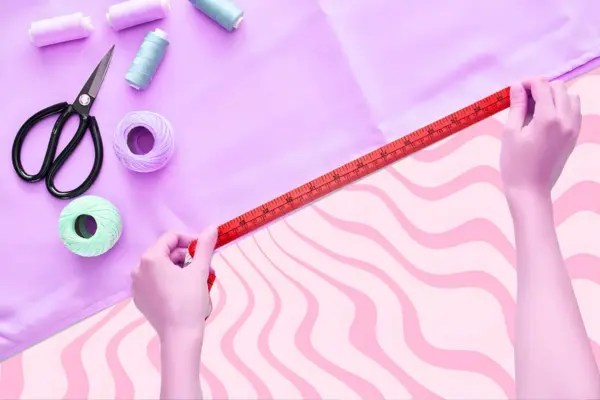Fabric Width Conversion Chart
Fabric Width Conversion Chart
| Inches | Centimeters (cm) |
|---|---|
| 36″ | 91.44 cm |
| 44″ | 111.76 cm |
| 54″ | 137.16 cm |
| 60″ | 152.40 cm |
| 72″ | 182.88 cm |
| 90″ | 228.60 cm |
| 108″ | 274.32 cm |
| 120″ | 304.80 cm |
Ever found yourself puzzled by fabric measurements when switching between inches and centimeters? A fabric width conversion chart is the ultimate tool for effortlessly converting fabric dimensions, ensuring your projects turn out just right. Whether you’re sewing curtains, crafting clothes, or tackling a quilting masterpiece, knowing how to adapt fabric widths is a skill every crafter needs. In this guide, we’ll explain the concept, share an easy formula, work through examples, and explore how to use this tool in various creative projects.
Table of Contents
What Is a Fabric Width Conversion Chart?
A fabric width conversion chart helps you adjust fabric measurements between different units, like inches and centimeters. It’s essential for anyone working with patterns, especially when fabric is sold in widths that differ from the project’s requirements.

Why is this important? Imagine you’re working on a pattern that calls for fabric 45 inches wide, but your local store sells it in centimeters. Without converting, you might end up buying too much or too little fabric, which could ruin your project or waste money.
Formula for Fabric Width Conversion
Let’s break it down:
Converted Width = (Original Width × Desired Unit Factor) ÷ Original Unit Factor
- Original Width: The width of the fabric in the unit you currently have (e.g., inches).
- Original Unit Factor: The factor representing your original unit (e.g., 1 for inches, 2.54 for centimeters).
- Desired Unit Factor: The factor representing the unit you want to convert to.
This formula simplifies the conversion process, ensuring you get accurate results every time.
How to Use a Fabric Width Conversion Chart
Using a fabric width conversion chart or calculator is straightforward. Follow these steps:
- Measure Your Fabric: Identify the width of your fabric in the unit provided (e.g., 45 inches or 115 cm).
- Select the Desired Unit: Decide if you need the measurement in inches or centimeters.
- Use the Formula or Chart: Plug the values into the formula or reference a ready-made conversion chart to get your answer.
- Apply the Conversion: Use the converted width to plan your project or purchase the correct amount of fabric.
Simplified Example of Fabric Width Conversion
Let’s say you have fabric that’s 45 inches wide, but your pattern provides measurements in centimeters.
- Start with the Formula:
Converted Width = (Original Width × Desired Unit Factor) ÷ Original Unit Factor - Substitute the Values:
- Original Width = 45 inches
- Desired Unit Factor = 2.54 (to convert to cm)
- Original Unit Factor = 1 (since we’re starting with inches)
- Calculate the Result:
Converted Width = 114.3 cm
So, 45 inches equals 114.3 cm. Now, you know the equivalent width in centimeters!
Detailed Example with Questions and Solutions
Scenario:
You’re sewing a tablecloth using a pattern designed for fabric that’s 120 cm wide, but your local store only sells fabric in inches. How do you find the equivalent width in inches?
- Use the Formula:
Converted Width = (Original Width × Desired Unit Factor) ÷ Original Unit Factor - Plug in the Numbers:
- Original Width = 120 cm
- Desired Unit Factor = 1 (to convert to inches)
- Original Unit Factor = 2.54 (since centimeters are the original unit)
- Perform the Calculation:
Converted Width = 47.24 inches
Answer: You’ll need fabric that’s approximately 47.25 inches wide to match the pattern’s requirements.
Applications of a Fabric Width Conversion Chart
A fabric width conversion chart isn’t just a fancy tool—it’s a lifesaver in many scenarios.
1. Sewing Patterns from Different Regions
Patterns from the U.S. use inches, while European patterns often use centimeters. Converting fabric widths ensures consistency when working with international designs.
2. Quilting Projects
Quilters often deal with specific fabric widths for blocks or fabric backing. Conversion charts help ensure the right fabric size without waste.
3. Home Décor Projects
From curtains to cushions, knowing exact fabric widths in your preferred unit avoids last-minute trips to the fabric store.
4. Online Fabric Shopping
When buying fabric online, sellers may list dimensions in unfamiliar units. A conversion chart ensures you order the right size.
Why You Need This Tool
- Saves Money: Avoid overbuying fabric by converting measurements accurately.
- Improves Accuracy: Align your project measurements with the fabric’s width to achieve perfect results.
- Streamlines Projects: Spend less time on math and more time crafting!
Conclusion
A fabric width conversion chart is more than a tool—it’s your crafting companion. Whether you’re sewing clothing, quilting, or decorating your home, understanding fabric conversions ensures your projects go off without a hitch. The formula is simple, the process is quick, and the results? Flawless. So, the next time you find yourself switching between inches and centimeters, remember: a little math can save a lot of headaches!
1. Can I use this chart for fabric length as well?
Yes! The same formula applies when converting fabric lengths between inches and centimeters.
2. What if my fabric width is not listed in the chart?
You can always use the formula to calculate custom widths based on your needs.
3. Are there online calculators for fabric width conversion?
Absolutely! Many websites offer fabric width calculators to make the process even easier.
4. Does fabric type affect conversion?
No, the conversion process applies to all fabric types, as it’s purely a measurement calculation.
5. How do I handle fractions when converting?
Round fractions to the nearest decimal place for simplicity, or use a calculator for precise measurements.
